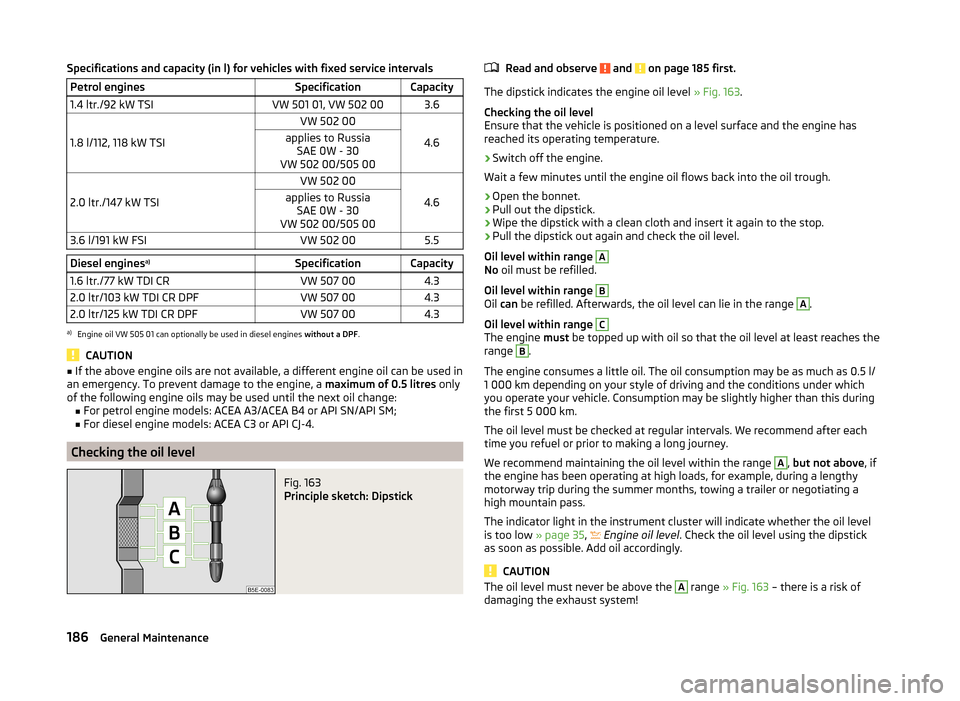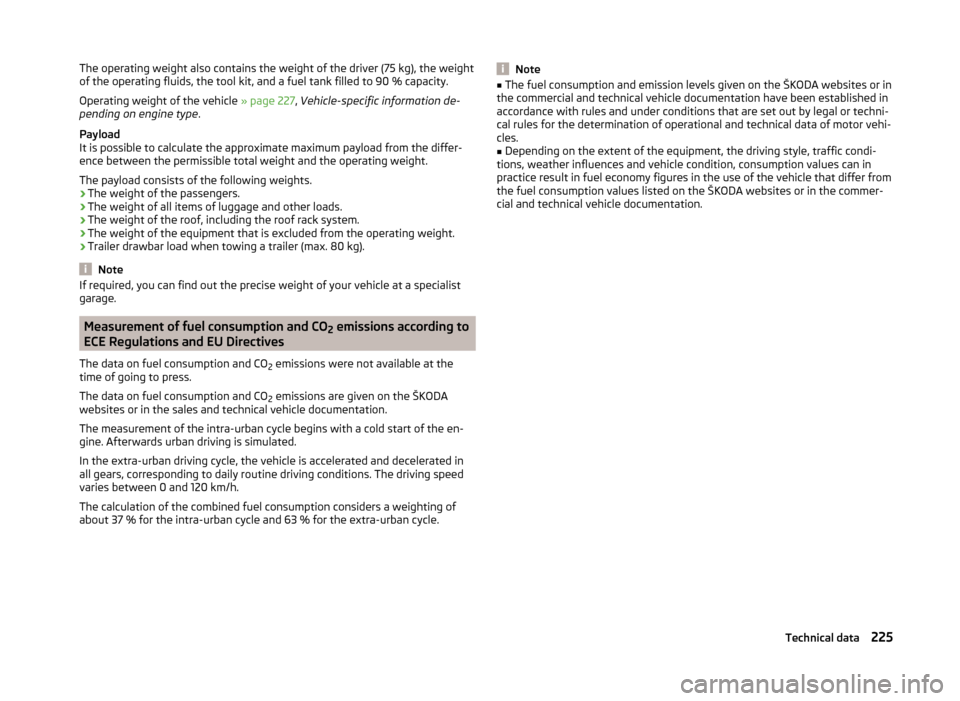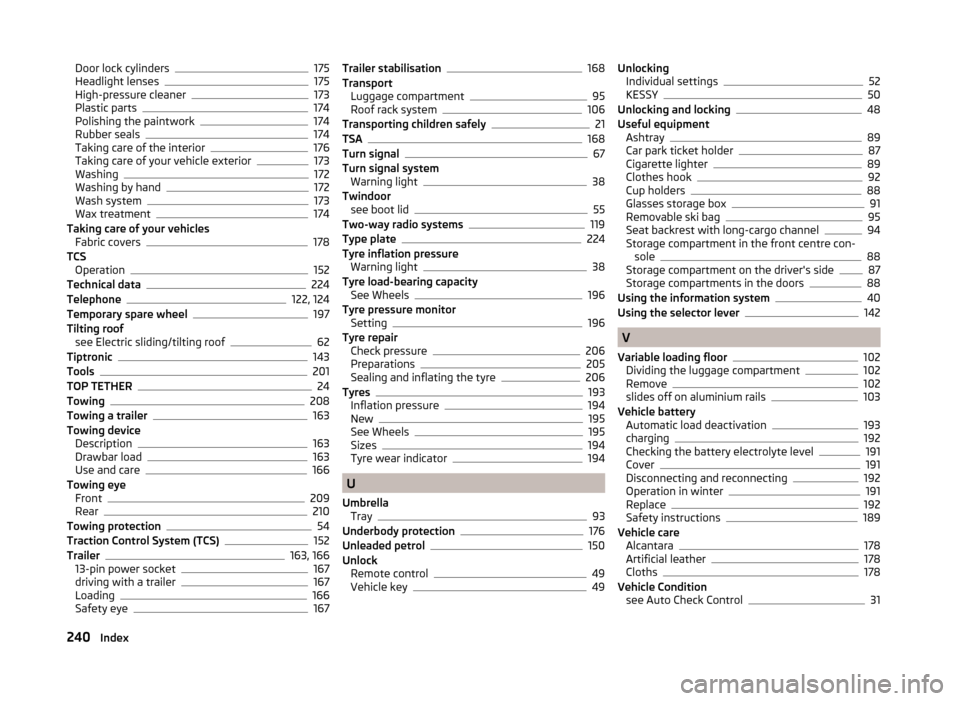towing capacity SKODA SUPERB 2014 2.G / (B6/3T) Owner's Manual
[x] Cancel search | Manufacturer: SKODA, Model Year: 2014, Model line: SUPERB, Model: SKODA SUPERB 2014 2.G / (B6/3T)Pages: 246, PDF Size: 17.16 MB
Page 188 of 246

Specifications and capacity (in l) for vehicles with fixed service intervalsPetrol enginesSpecificationCapacity1.4 ltr./92 kW TSIVW 501 01, VW 502 003.6
1.8 l/112, 118 kW TSI
VW 502 00
4.6
applies to RussiaSAE 0W - 30
VW 502 00/505 00
2.0 ltr./147 kW TSI
VW 502 00
4.6
applies to Russia SAE 0W - 30
VW 502 00/505 003.6 l/191 kW FSIVW 502 005.5Diesel engines a)SpecificationCapacity1.6 ltr./77 kW TDI CRVW 507 004.32.0 ltr/103 kW TDI CR DPFVW 507 004.32.0 ltr/125 kW TDI CR DPFVW 507 004.3a)
Engine oil VW 505 01 can optionally be used in diesel engines
without a DPF.
CAUTION
■
If the above engine oils are not available, a different engine oil can be used in
an emergency. To prevent damage to the engine, a maximum of 0.5 litres only
of the following engine oils may be used until the next oil change: ■ For petrol engine models: ACEA A3/ACEA B4 or API SN/API SM;
■ For diesel engine models: ACEA C3 or API CJ-4.
Checking the oil level
Fig. 163
Principle sketch: Dipstick
Read and observe and on page 185 first.
The dipstick indicates the engine oil level » Fig. 163.
Checking the oil level
Ensure that the vehicle is positioned on a level surface and the engine has
reached its operating temperature.
›
Switch off the engine.
Wait a few minutes until the engine oil flows back into the oil trough.
›
Open the bonnet.
›
Pull out the dipstick.
›
Wipe the dipstick with a clean cloth and insert it again to the stop.
›
Pull the dipstick out again and check the oil level.
Oil level within range
A
No oil must be refilled.
Oil level within range
B
Oil can be refilled. Afterwards, the oil level can lie in the range
A
.
Oil level within range
C
The engine must be topped up with oil so that the oil level at least reaches the
range
B
.
The engine consumes a little oil. The oil consumption may be as much as 0.5 l/
1 000 km depending on your style of driving and the conditions under which
you operate your vehicle. Consumption may be slightly higher than this during
the first 5 000 km.
The oil level must be checked at regular intervals. We recommend after each
time you refuel or prior to making a long journey.
We recommend maintaining the oil level within the range
A
, but not above , if
the engine has been operating at high loads, for example, during a lengthy
motorway trip during the summer months, towing a trailer or negotiating a
high mountain pass.
The indicator light in the instrument cluster will indicate whether the oil level
is too low » page 35,
Engine oil level
. Check the oil level using the dipstick
as soon as possible. Add oil accordingly.
CAUTION
The oil level must never be above the A range » Fig. 163 – there is a risk of
damaging the exhaust system!186General Maintenance
Page 227 of 246

The operating weight also contains the weight of the driver (75 kg), the weight
of the operating fluids, the tool kit, and a fuel tank filled to 90 % capacity.
Operating weight of the vehicle » page 227, Vehicle-specific information de-
pending on engine type .
Payload
It is possible to calculate the approximate maximum payload from the differ-
ence between the permissible total weight and the operating weight.
The payload consists of the following weights.
› The weight of the passengers.
› The weight of all items of luggage and other loads.
› The weight of the roof, including the roof rack system.
› The weight of the equipment that is excluded from the operating weight.
› Trailer drawbar load when towing a trailer (max. 80 kg).
Note
If required, you can find out the precise weight of your vehicle at a specialist
garage.
Measurement of fuel consumption and CO 2 emissions according to
ECE Regulations and EU Directives
The data on fuel consumption and CO 2 emissions were not available at the
time of going to press.
The data on fuel consumption and CO 2 emissions are given on the ŠKODA
websites or in the sales and technical vehicle documentation.
The measurement of the intra-urban cycle begins with a cold start of the en-
gine. Afterwards urban driving is simulated.
In the extra-urban driving cycle, the vehicle is accelerated and decelerated in
all gears, corresponding to daily routine driving conditions. The driving speed
varies between 0 and 120 km/h.
The calculation of the combined fuel consumption considers a weighting of
about 37 % for the intra-urban cycle and 63 % for the extra-urban cycle.
Note■ The fuel consumption and emission levels given on the ŠKODA websites or in
the commercial and technical vehicle documentation have been established in
accordance with rules and under conditions that are set out by legal or techni-
cal rules for the determination of operational and technical data of motor vehi-
cles.■
Depending on the extent of the equipment, the driving style, traffic condi-
tions, weather influences and vehicle condition, consumption values can in
practice result in fuel economy figures in the use of the vehicle that differ from
the fuel consumption values listed on the ŠKODA websites or in the commer-
cial and technical vehicle documentation.
225Technical data
Page 242 of 246

Door lock cylinders175
Headlight lenses175
High-pressure cleaner173
Plastic parts174
Polishing the paintwork174
Rubber seals174
Taking care of the interior176
Taking care of your vehicle exterior173
Washing172
Washing by hand172
Wash system173
Wax treatment174
Taking care of your vehicles Fabric covers
178
TCS Operation
152
Technical data224
Telephone122, 124
Temporary spare wheel197
Tilting roof see Electric sliding/tilting roof
62
Tiptronic143
Tools201
TOP TETHER24
Towing208
Towing a trailer163
Towing device Description
163
Drawbar load163
Use and care166
Towing eye Front
209
Rear210
Towing protection54
Traction Control System (TCS)152
Trailer163, 166
13-pin power socket167
driving with a trailer167
Loading166
Safety eye167
Trailer stabilisation168
Transport Luggage compartment
95
Roof rack system106
Transporting children safely21
TSA168
Turn signal67
Turn signal system Warning light
38
Twindoor see boot lid
55
Two-way radio systems119
Type plate224
Tyre inflation pressure Warning light
38
Tyre load-bearing capacity See Wheels
196
Tyre pressure monitor Setting
196
Tyre repair Check pressure
206
Preparations205
Sealing and inflating the tyre206
Tyres193
Inflation pressure194
New195
See Wheels195
Sizes194
Tyre wear indicator194
U
Umbrella Tray
93
Underbody protection176
Unleaded petrol150
Unlock Remote control
49
Vehicle key49
Unlocking Individual settings52
KESSY50
Unlocking and locking48
Useful equipment Ashtray
89
Car park ticket holder87
Cigarette lighter89
Clothes hook92
Cup holders88
Glasses storage box91
Removable ski bag95
Seat backrest with long-cargo channel94
Storage compartment in the front centre con- sole
88
Storage compartment on the driver's side87
Storage compartments in the doors88
Using the information system40
Using the selector lever142
V
Variable loading floor
102
Dividing the luggage compartment102
Remove102
slides off on aluminium rails103
Vehicle battery Automatic load deactivation
193
charging192
Checking the battery electrolyte level191
Cover191
Disconnecting and reconnecting192
Operation in winter191
Replace192
Safety instructions189
Vehicle care Alcantara
178
Artificial leather178
Cloths178
Vehicle Condition see Auto Check Control
31
240Index